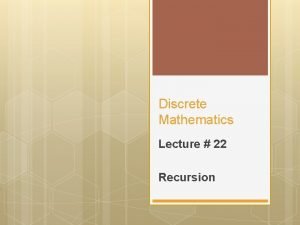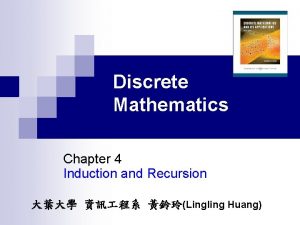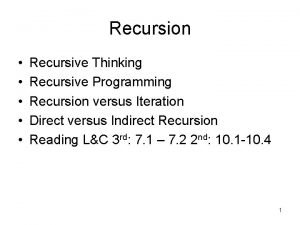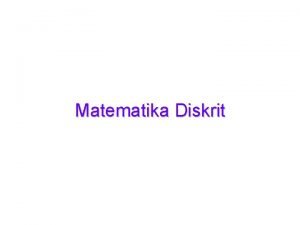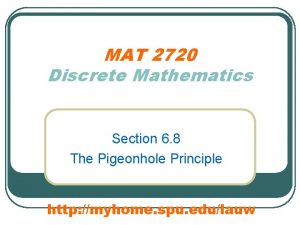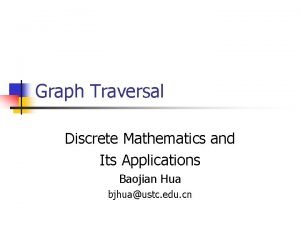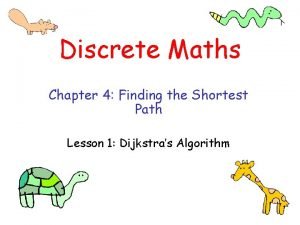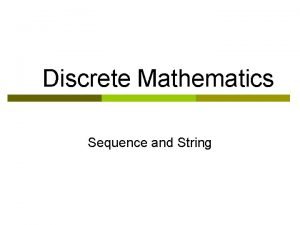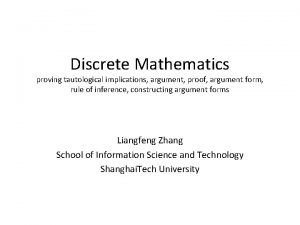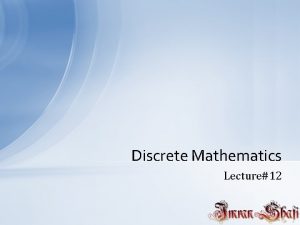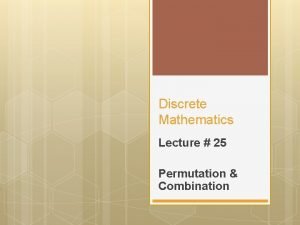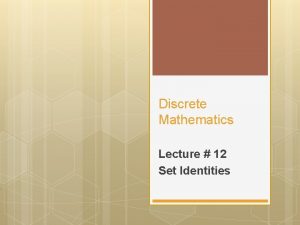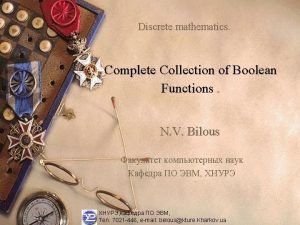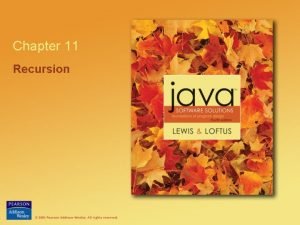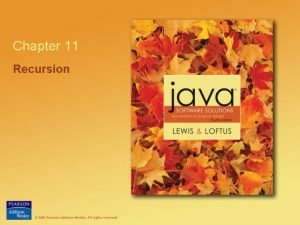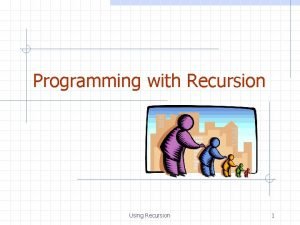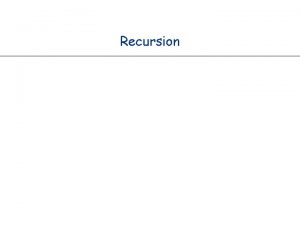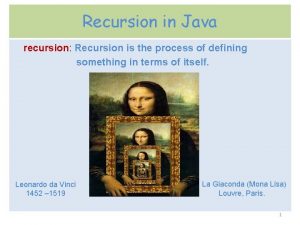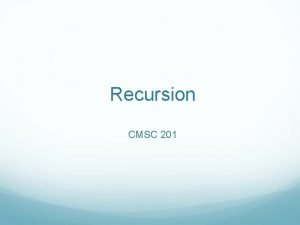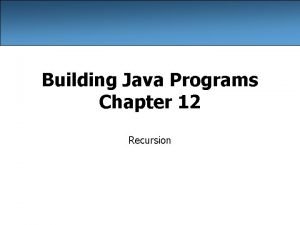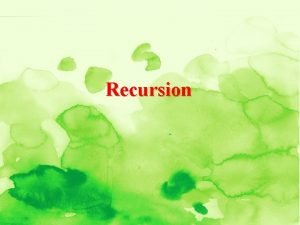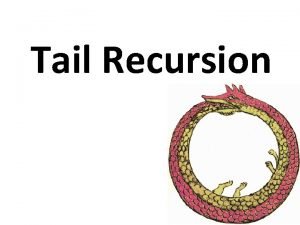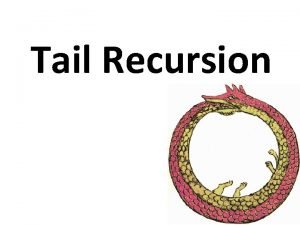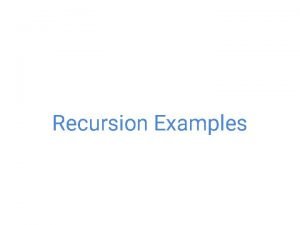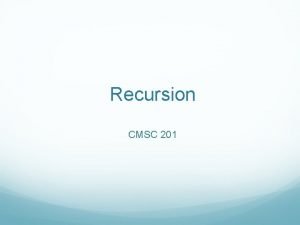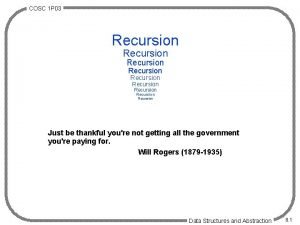Discrete Mathematics Lecture16 Recursion First of all instead

















- Slides: 17

Discrete Mathematics Lecture#16

Recursion First of all instead of giving the definition of Recursion we give you an example, you already know the Set of Odd numbers Here we give the new definition of the same set that is the set of Odd numbers. Definition for odd positive integers may be given as: BASE: 1 is an odd positive integer. RECURSION: If k is an odd positive integer, so is k + 2

Recursion Now, 1 is an odd positive integer by the definition base. With k = 1, 1 + 2 = 3, so 3 is an odd positive integer. With k = 3, 3 + 2 = 5, so 5 is an odd positive integer and so, 7, 9, 11, … are odd positive integers. REMARK: Recursive definitions can be used in a “generative” manner

Recursion The process of defining an object in terms of smaller versions of itself is called recursion. A recursive definition has two parts: BASE An initial simple definition which cannot be expressed in terms of smaller versions of itself RECURSION The part of definition which can be expressed in terms of smaller versions of itself

Recursion Principle A function is said to be recursively defined if the function refers to itself such that: 1. There are certain arguments, called base values, for which the function does not refer to itself 2. Each time the function does refer to itself, the argument of the function must be closer to a base value

Recursion: Example Suppose that f is defined recursively by f(0) = 3, f(n+1) = 2 f(n) + 3 Find f(1), f(2), f(3) and f(4).

Recursion: Example Find f(2), f(3), and f(4) if f is defined recursively by f(0) = -1, f(1)=2 and for n = 1, 2, 3, … f(n+1) = f(n) + 3 f(n - 1)

Factorial Function N! = N X (N-1) X (N-2) …. . X 2 X 1 Recursive definition of factorial function is: Factorial(0) = 1 Factorial(n) = n Factorial(n-1)

Factorial Function N! = N X (N-1) X (N-2) …. . X 2 X 1 Recursive definition of factorial function is: Factorial(0) = 1 Factorial(n) = n Factorial(n-1)

Sum Function Let S be the function such that S(n) is the sum of the first n positive integers. Give a recursive definition of S(n). Solution: Initial value of this function may be specified as S(0)=0 Since S(n) = n + (n - 1) + (n - 2) + … + 3 + 2 + 1 = n + [(n - 1) + (n - 2) + … + 3 + 2 + 1] = n + S(n-1) which defines the recursive step. Accordingly S may be defined as: 1. S(0)= 0 2. S(n) = n + S(n - 1) for n 1

Sum Function Let a and b denote positive integers. Suppose a function Q is defined recursively as follows: Find the value of Q(2, 3) and Q(14, 3) What does this function do? Find Q (3355, 7)

Fibonacci Series The Fibonacci sequence is defined as follows. F 0=1, F 1=1 Fk = F k – 1 + F k – 2 for all integers k 2 F 2 = F 1 + F 0 = 1 + 1 = 2 F 3 = F 2 + F 1 = 2 + 1 = 3 F 4 = F 3 + F 2 = 3 + 2 = 5 F 5 = F 4 + F 3 = 5 + 3 = 8. . .

Recurrence Relation A recurrence relation for a sequence a 0, a 1, a 2, . . . , is a formula that relates each term ak to certain of its predecessors ak – 1, ak – 2, . . . , ak – i , where i is a fixed integer and k is any integer greater than or equal to i. The initial conditions for such a recurrence relation specify the values of a 0, a 1, a 2, . . . , . ai – 1

Recurrence Relation: Example Find the first four terms of the following recursively defined sequence. b 1 = 2 bk = bk – 1 + 2 · k, for all integers k 2

Recurrence Relation: Example Find the first five terms of the following recursively defined sequence. t 0 = – 1, t 1 = 1 tk = t k – 1 + 2 · t k – 2 , for all integers k 2

Recurrence Relation: Example Define a sequence b 0, b 1, b 2, . . . by the formula b n = 5 n, for all integers n 0. Show that this sequence satisfies the recurrence relation bk = 5 bk – 1, for all integers k 1.

Recurrence Relation: Example Show that the sequence 0, 1, 3, 7, . . . , 2 n – 1, . . . , for n 0, satisfies the recurrence relation dk = 3 dk – 1 – 2 dk – 2, for all integers k 2
 Recursive definition in discrete mathematics
Recursive definition in discrete mathematics Induction and recursion discrete mathematics
Induction and recursion discrete mathematics To understand recursion you must understand recursion
To understand recursion you must understand recursion Recursion vs loop
Recursion vs loop Rosen discrete mathematics solutions
Rosen discrete mathematics solutions Pigeonhole principle in discrete mathematics
Pigeonhole principle in discrete mathematics Proof by contradiction discrete math
Proof by contradiction discrete math Hukum kesetaraan logis
Hukum kesetaraan logis Dfs in discrete mathematics
Dfs in discrete mathematics Dijkstra algorithm in discrete mathematics
Dijkstra algorithm in discrete mathematics Sequences discrete math
Sequences discrete math Tautological implication
Tautological implication Symmetric relation example
Symmetric relation example Application of propositional logic in discrete mathematics
Application of propositional logic in discrete mathematics Permutation and combination in discrete mathematics
Permutation and combination in discrete mathematics Set identities examples
Set identities examples Boolean functions in discrete mathematics
Boolean functions in discrete mathematics Discrete probability and advanced counting techniques
Discrete probability and advanced counting techniques
